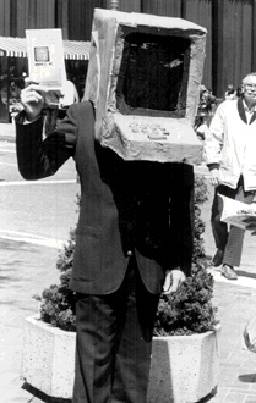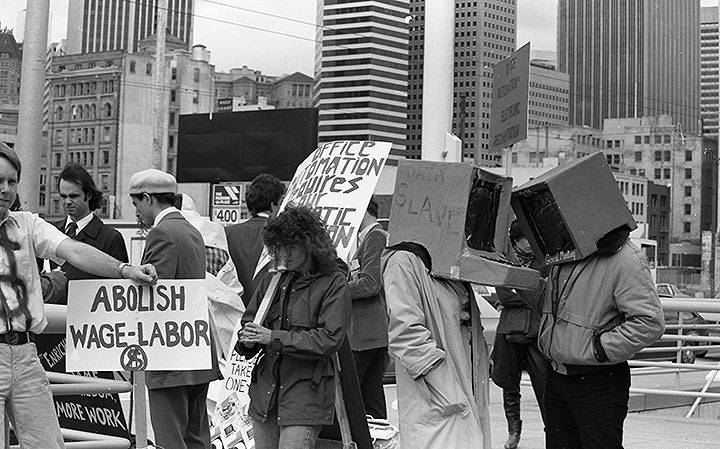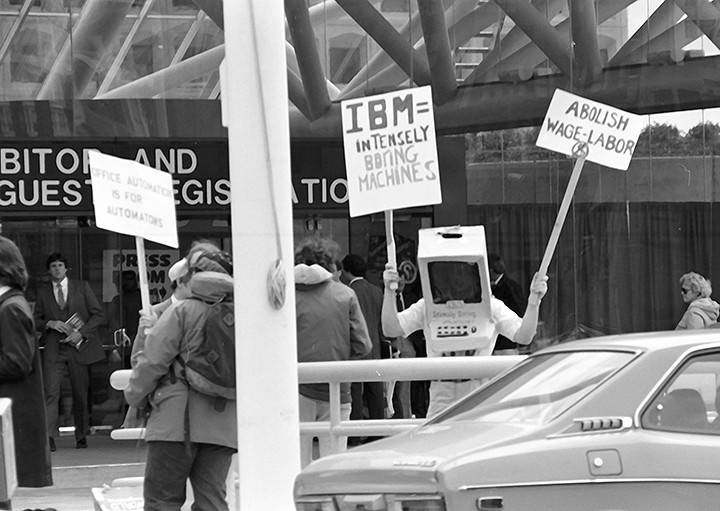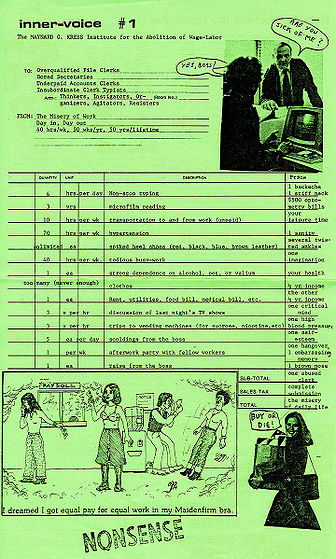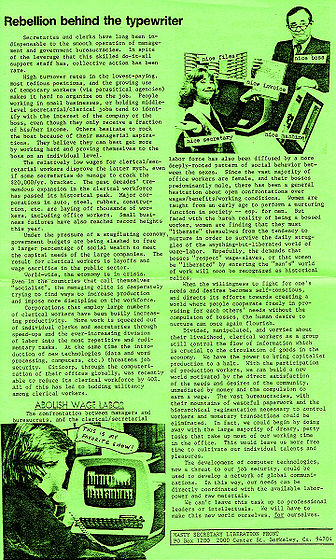WHAT DO SAN FRANCISCANS DO ALL DAY? Information Work
Historical Essay
by Chris Carlsson
Processed World vendor agitator, summer 1981.
Photo: Caitlin Manning
Protesting the "Office Automaton Conference" in 1982 at San Francisco's Moscone Convention Center.
Photo: Caitlin Manning
| Information processing, or work that involves producing and distributing data, has increased in the Post WWII era with the introduction of new industries such as global manufacturing, advertising, law, insurance, private medicine, banking, as well as expanding governmental bureaucracies. These fields feed off one another to create spiraling demand for such services. The author examines the impact of this Information Age on employment and the workforce trained in the university systems. |
In the post-WWII era, big US companies were growing rapidly. To take advantage of the geographically large US market, many companies built facilities across the country. Often this led to greater and more complex flows of raw materials, semi-finished, and finished products. Similarly, many companies took advantage of U.S. hegemony in the '40s and '50s to establish manufacturing facilities in Europe, Asia and Latin America -- to take advantage of those markets, as well of the lower wages and absence of governmental regulation. Dispersion of a corporation's production and distribution facilities throughout the world complicates record-keeping at all levels, creating ever greater needs for "administrative support" (read, office work).
Along with expanding markets came the need to publicize new products. Advertising, which first came into its own in the 1920's, really grew in the '50s and '60s along with television. Entertainment, constantly interrupted by advertisements, glamorized ever newer and fancier consumer goods. Industries like film, recording, publishing and advertising, geared to the production and dissemination of "information," hired thousands of workers to design products and publicity, as well as to buy and sell these information commodities.
Innumerable disputes and conflicts evolved from the complex relationships within and between different businesses and business sectors. These, plus the ever-growing load of governmental regulation and constantly changing tax laws, led to the extraordinary growth of legal work and its millions of lawyers, researchers, clerks, reporters, examiners, etc. The vast majority of litigation involves corporations and government agencies, and focuses on their control of markets, products, and profits. Partly to protect themselves in court, all companies now produce and maintain at least duplicate records of everything (triplicate and quadruplicate records are common in accounting and legal firms). Memos and contracts have become the final proof of what is "real." All of this calls for millions of workers to write, type, copy, file and retrieve the information.
Another participant in the litigation merry-go-round has been the insurance industry. The increasingly complex economy has created more possibilities for things to go wrong, which in turn has caused the insurance industry to boom. Since everything that goes wrong implies a financial liability for someone, it isn't surprising that everyone wants to buy protection from potentially catastrophic losses due to accident (or due to the consequences of deliberately cutting corners in the scramble to get an advantage over competitors). Nor is it surprising that insurance companies have spent a good deal of money on lawsuits to avoid paying even more money to beneficiaries and/or victims. Insurance companies now employ millions of office workers and thousands of lawyers and paralegals and wield enormous power in investment decisions through their control of vast pools of capital derived from premiums. Because of their importance as money managers, the insurance and banking industries can be expected to become increasingly integrated.
Hand in hand with the growth of the insurance industry has been the explosion in the private medical industry. Doctors, laboratories, pharmaceutical companies, non-profit foundation and private hospital owners, and thousands of clericals, computer operators, programmers, nurses, janitors, and so on, have multiplied many times since the early 1960s. Many billions are being spent every year on medical services, much of it on self-referential information processing.
One of the much-publicized features of the past 45 years has been the astounding growth of government bureaucracies at every level--municipal, county, state and federal. In spite of the current attempts to curb governmental growth this sector of the economy still employs more than 6 million information workers.
1982 Office Automatons at the Office Automation Conference at the Moscone Center.
Photo: Caitlin Manning
Yet another contributing factor to the growth of office employment has been 20 years of merger-mania--the remarkable rise of conglomerates, or large holding companies which own numerous manufacturing, distributing and/or financial subsidiaries. Bureaucracy grows as each subsidiary has to devote time and money to comply with the information needs of its parent. Meanwhile parent companies becomes pure bureaucracies interested only in the flow of data (and profit) coming in from the subsidiaries.
The last and most important sector of "information work" is banking. This primarily used to consist of taking in corporate and individual deposits and loaning it out on interest. During the 1980s a remarkable wave of mergers and acquisitions between large banks, insurance companies, stock brokerages, real estate firms, commodities brokerages, and even large retailers like Sears Roebuck have reshaped corporate America. Now we are happily shopping for new "financial services," including the explosion of consumer and corporate credit, data processing and computer services, speculative investment in real estate, stock markets, money markets, commodities, etc., and ever expanding forms of insurance, retirement accounts, travellers' checks, and so on.
The much touted move to the automated office has not derailed this explosion in information handling work. Recent articles in Bay Area newspapers have cast doubt on the success of office automation in increasing productivity among the infamously inefficient office workforce. Decreases in overall office employment are much more likely to result from huge mergers like the Security Pacific Bank and Bank of America, which resulted in 10,000 fewer jobs around California, with a good many of those layoffs in San Francisco.
The Information Age is hailed as representing a more complex, challenging and meaningful world of work. While the university system continues to churn out well-trained information handlers (what is one better suited to, after a college education, than shuffling forms around and getting along with a bureaucracy?), a challenging and meaningful worklife is not what awaits them in downtown San Francisco.

